Nothing compares to the beauty, fragrance, and versatility of peonies. Peonies (Paeonia) have been cultivated for thousands of years and are named after Paeon, a character from Greek mythology. Peonies are native to Asia, Europe, and Western North America. They are long-lived plants that will continue to produce blooms (seasonally) for up to 50 years. In many cultures, peonies are associated with love, romance, and good fortune. Peony roots and seeds have been used in traditional medicine for centuries to treat a variety of ailments. Peonies can have different flower forms, including a bomb-shaped variety with a large, round, full-bodied flower. These spectacular, sweetly-scented flowers will create a showing-stopping springtime display in your garden or on your patio. Keep reading for your complete guide on how to grow peonies.
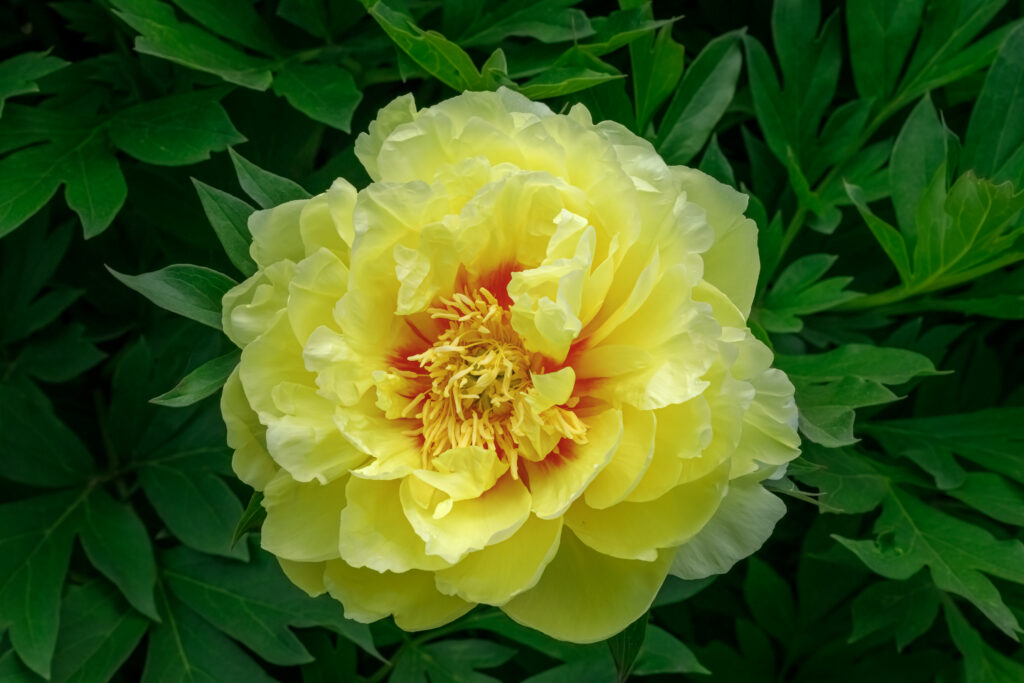
These spectacular, sweetly-scented flowers will create a showing-stopping springtime display in your garden or on your patio.
©Nnattalli/Shutterstock.com
How to Grow Peonies: Plant Selection
There are many different species and cultivars within the complex and evolving genus Paeonia.
Paeonia is a large and diverse genus that includes both herbaceous and woody species. There are three main groups of peonies: the herbaceous peonies, like the common garden peony (Paeonia lactiflora), the tree peonies (Paeonia suffruticosa), and the intersectional or Itoh peonies (hybrids between herbaceous and tree peonies). Within each of these groups, there are many different cultivars with variations in flower color, shape, size, and foliage. There are over 1,000 registered cultivars of herbaceous peonies alone.

There are over 1,000 registered cultivars of herbaceous peonies alone.
©Fusionstudio/Shutterstock.com
How to Grow Peonies: Understanding the Different Varieties
Herbaceous peonies are the most commonly grown and are characterized by their soft, herbaceous stems that die back to the ground each winter. They bloom in late spring to early summer, producing large, showy flowers in a wide range of colors.
Tree peonies have woody stems that persist year-round. They can grow into small trees or large shrubs. They bloom earlier in the season than herbaceous peonies and have large, beautiful flowers in shades of pink, white, yellow, or red.
Intersectional or Itoh peonies are a relatively new type of peony that is a hybrid between herbaceous and tree peonies. They have the best of both worlds, with the large, showy flowers of tree peonies and the hardiness and disease resistance of herbaceous peonies.

Tree peonies have woody stems that persist year-round. They can grow into small trees or large shrubs.
©Flower_Garden/Shutterstock.com
Herbaceous Peonies
Herbaceous peonies are considered the easiest to grow among the three types. They are generally hardy, disease-resistant, and require little maintenance once established. Herbaceous peonies prefer full sun but can also tolerate some shade. They grow well in a wide range of soil types as long as the soil is well-drained. They are also relatively drought-tolerant, although they will perform better with regular watering during dry spells. Overall, herbaceous peonies are an excellent choice for gardeners looking for a low-maintenance, long-lived perennial with stunning, aromatic blooms. Although there are only a few species of herbaceous peonies that are commonly grown in gardens, there are countless cultivars available.

Herbaceous peonies are generally hardy, disease-resistant, and require little maintenance once established.
©Snowbelle/Shutterstock.com
How to Grow Peonies: Plant Selection – Categories of Herbaceous Blooms
There are six main categories of herbaceous peony flower blossoms, each with its own individual characteristics:
- The single peony has a single row of petals surrounding a cluster of stamens. This is the simplest form of a peony blossom, but it is also one of the most elegant. Single peonies are available in a wide range of colors, from white to deep red.
- The Japanese peony has a single or double row of petals surrounding a center of stamens, but with petaloid (sterile stamens) instead of normal petals in the center. The petaloid can be of the same color or a different color than the outer petals, creating a unique and eye-catching look. Japanese peonies are also available in a range of colors, from white to deep red.
- The anemone peony has a central cluster of petaloid surrounded by one or more rows of broad petals. The petaloid can be of the same or a different color than the outer petals, creating a striking contrast. Anemone peonies are available in a range of colors, from white to pink to deep red.
- The semi-double peony has two or three rows of petals surrounding a center of stamens. The petals can be broad or narrow, and they may overlap or be arranged in a spiral pattern. Semi-double peonies are available in a range of colors, from white to pink to deep red.
- The bomb peony has a central cluster of petals surrounded by one or more rows of broad petals. The central cluster is often a different color than the outer petals, creating a striking contrast. Bomb peonies are available in a range of colors, from white to pink to deep red.
- The full double peony has multiple rows of broad petals surrounding a center of stamens, which are usually hidden from view. The petals can be tightly packed or slightly open, creating a ruffled or frilly appearance. Full double peonies are available in a range of colors, from white to pink to deep red.
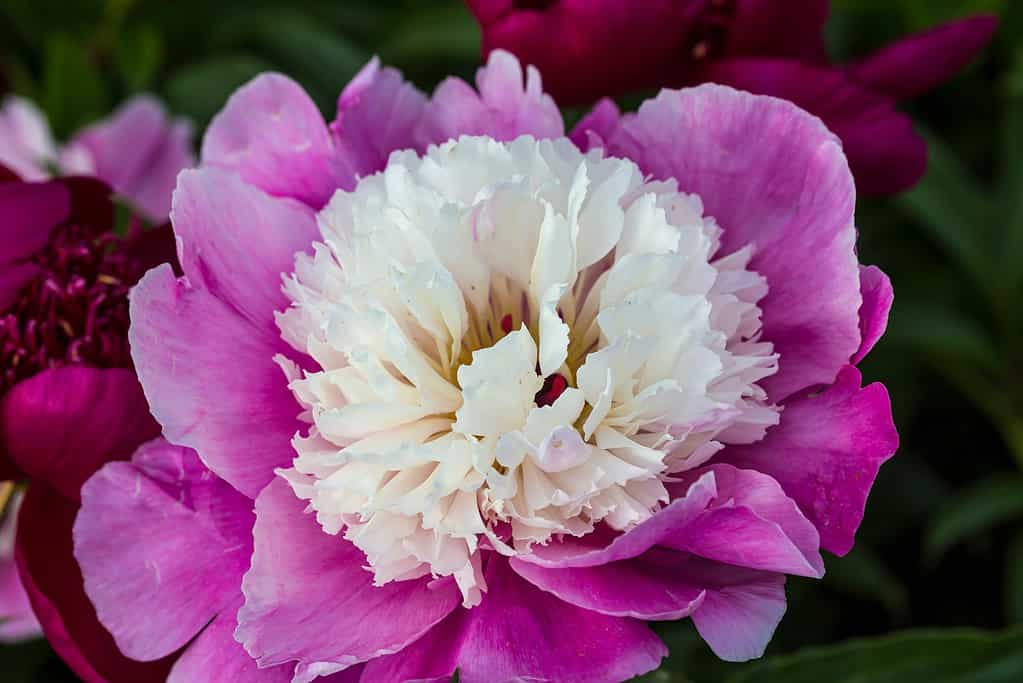
The petaloid can be of the same color or a different color than the outer petals, creating a unique and eye-catching look. Japanese peonies are also available in a range of colors, from white to deep red. Pictured: Semi-double candy pink Japanese-style peony Cora Stubbs.
©Anatolii Lyzun/Shutterstock.com
How to Grow Peonies: Choosing a Method
While it’s possible to grow peonies from seed, growing peonies from seed is a slow and unpredictable process, and the resulting plants may not be true to the parent form. This is because peonies are often hybridized, and the seeds may not produce offspring that are identical to the parent. It will take several years from the time the seeds are planted to the time they grow into mature plants that flower. For this reason, most peonies are propagated vegetatively, using the methods of division, or cutting propagation.
If you do decide to grow peonies from seed, it is best to start with fresh, viable seed that has been harvested from healthy, disease-free plants. The seeds should be sown in well-draining soil and kept moist but not waterlogged. It is also important to provide the seeds with a period of cold stratification before planting. For peony seeds, cold stratification is accomplished by placing the seed in the vegetable drawer of your refrigerator for at least 3 months, as this mimics the natural winter conditions that many peony seeds require for successful germination.

While it’s possible to grow peonies from seed, it is important to note that growing peonies from seed is a slow and unpredictable process.
©alex172/Shutterstock.com
Propagation By Division
Division is a common technique used to propagate peonies. It involves separating a mature plant into smaller sections or divisions, each with its roots and shoots. This is typically done in the fall when the plant is dormant.
Here are the general steps for dividing a peony plant:
1 Choose a mature peony plant that is at least three years old and has multiple stems or “eyes.”
2 Dig up the entire plant and gently shake off any excess soil to expose the roots.
3 Use a sharp, sterile knife or garden spade to carefully separate the plant into smaller sections, making sure that each section has at least one stem or eye and a healthy root system.
4 Trim any damaged or diseased roots or foliage, and dust the cut surfaces with a fungicide to prevent infection.
5 Plant each division in a new location, making sure to bury the roots at the same depth as they were in the original plant.
6 Water the newly planted divisions thoroughly and keep the soil evenly moist for the first few weeks to help them establish.
Dividing peonies not only helps to propagate new plants but can also rejuvenate an old plant that has become overgrown or has stopped producing flowers. It is important to note that peonies do not respond well to frequent or severe division, so it is best to only divide the plant every few years, allowing it to establish and mature between divisions.

Division is a common technique used to propagate peonies involving separating a mature plant into smaller sections or divisions,
©Joanna Stankiewicz-Witek/Shutterstock.com
Propagation Through Stem Cuttings
Cutting propagation is a method of propagating peonies that involves taking a cutting or stem from a parent plant and rooting it to produce a new plant. This technique is typically done in the early spring or early fall when the peony is dormant.
Here are the general steps for cutting propagation of peonies:
1 Choose a healthy parent plant that has desirable characteristics, such as flower color or form.
2 Select a young, healthy stem from the parent plant that is approximately 6-8 inches long and has at least one node.
3 Make a clean, sharp cut at a 45-degree angle just below the node, using a sterile cutting tool.
4 Remove any lower leaves or buds from the stem, leaving only a few leaves at the top.
5 Dip the cut end of the stem into a rooting hormone powder to encourage root growth.
6 Plant the stem in a well-draining potting mix, making sure that the soil is evenly moist.
7 Cover the pot with a clear plastic bag or dome to create a humid environment and keep the soil moist.
8 Place the pot in a warm, bright location, but out of direct sunlight.
9 Check the cutting regularly for signs of new growth and root development. Once the cutting has rooted, gradually acclimate it to normal growing conditions and care for it as you would any other peony plant.
Cutting propagation can be a useful method for propagating peonies, especially for rare or hard-to-find cultivars. However, it is important to note that not all peonies are suitable for cutting propagation, and success rates can vary depending on the cultivar.
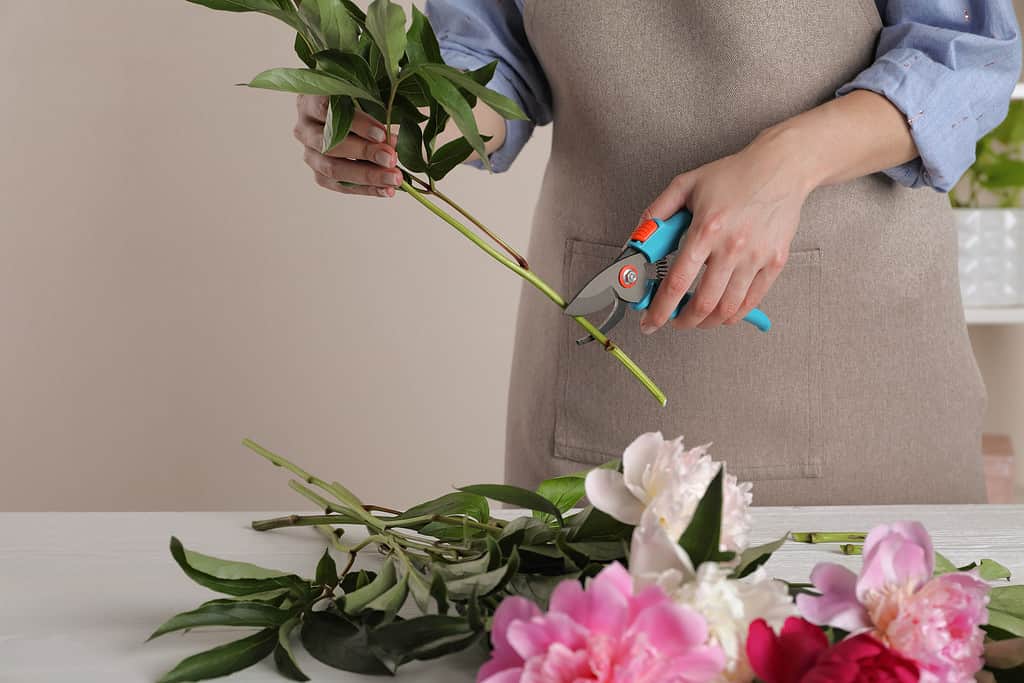
Cutting propagation is a method of propagating peonies that involves taking a cutting or stem from a parent plant and rooting it to produce a new plant.
©New Africa/Shutterstock.com
How to Grow Peonies: Planting
Peonies can be planted either in containers or directly into the ground, depending on your preference and growing conditions. Planting peonies in containers can be a good option if you have limited space or poor soil quality. Container-grown peonies can be moved around to take advantage of different light and temperature conditions, and they are also easier to protect from pests and diseases. However, planting peonies directly into the ground is the more popular method, especially if you have a larger garden and want to create a long-lasting, low-maintenance display of beautiful blooms. Whether you choose to plant your peonies in containers or in the ground, proper care and maintenance will help ensure healthy growth and abundant flowering.
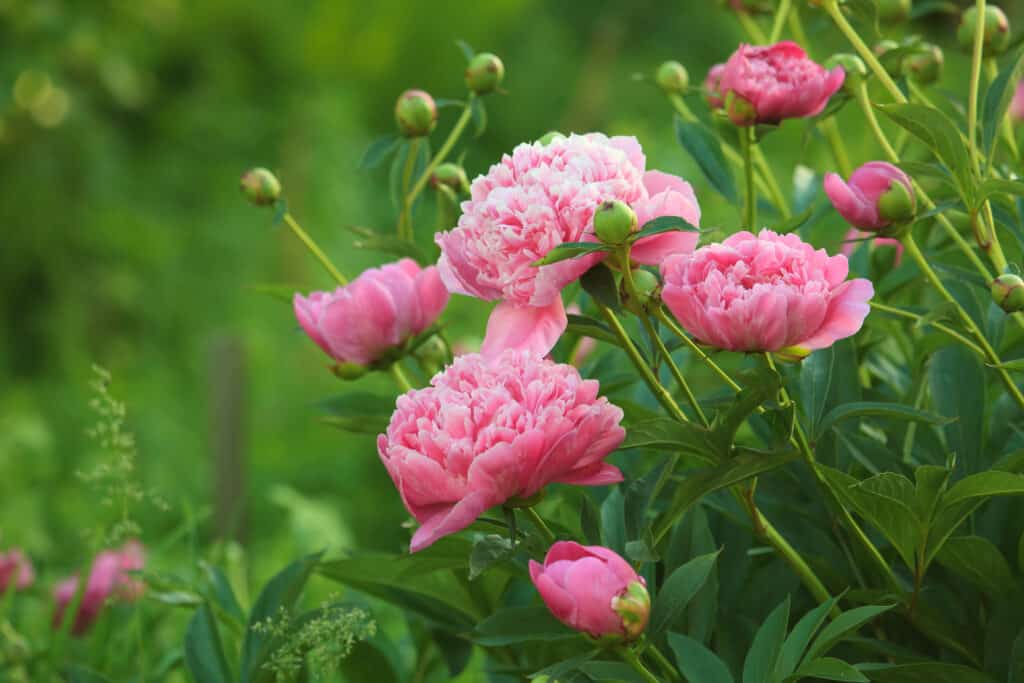
Peonies can be planted either in containers or directly into the ground, depending on your preference and growing conditions.
©iStock.com/Birute
Planting Peonies in a Container
Although they may require some extra care and attention to ensure that they thrive in a container environment, growing peonies in pots can be a good option for gardeners with limited space or for those who want to move their plants around to different locations throughout the growing season.
Here are some general tips for growing peonies in pots:
- Choose a large container: Peonies have a deep root system and require ample space to grow, so choose a pot that is at least 18-24 inches (45-60 cm) in diameter and 18-24 (45-60 cm) inches deep.
- Use well-draining soil: Peonies prefer well-draining soil that is rich in organic matter. Use a high-quality potting mix that contains perlite or vermiculite to improve drainage.
- Provide adequate water: Peonies require consistent moisture throughout the growing season, so be sure to water the pot thoroughly and regularly, especially during periods of hot, dry weather. However, be careful not to overwater, as this can lead to root rot and other problems.
- Give them enough sunlight: Peonies need at least 6-8 hours of direct sunlight each day to thrive, so place the pot in a sunny location or provide supplemental lighting if necessary.
- Fertilize regularly: Peonies benefit from regular fertilization, especially in pots where nutrients can quickly become depleted. Use a balanced fertilizer, such as a 10-10-10 or 5-10-5 formula, and apply it every 4-6 weeks throughout the growing season.
- Provide support: Peonies can become top-heavy when they produce their large flowers, so be sure to provide support for the stems to prevent them from bending or breaking. Use stakes or cages to support the plant.
- Overwinter the pots: If you live in a cold climate, you may need to overwinter the pots to protect the peonies from freezing temperatures. Move the pots to a sheltered location or cover them with a protective layer of mulch to insulate the soil.

Although they may require some extra care and attention to ensure that they thrive in a container environment, growing peonies in pots can be a good option for gardeners with limited space.
©tativophotos/Shutterstock.com
Easy Peasy
If you find yourself overscheduled, or you have a black thumb, or you’re just not that interested in gardening, but you wouldn’t mind a pop of springtime color, you can often purchase potted peonies at garden centers. Potted peonies are a convenient way to start growing peonies in your garden, as they are already established plants with a well-developed root system.
Planting Peonies in the Ground
When planting peonies in the ground, best practices recommend:
- Choose a suitable location: Peonies prefer a location that receives at least 6-8 hours of direct sunlight per day and has well-draining soil. Avoid planting them in areas that are prone to waterlogging, as this can lead to root rot.
- Prepare the soil: Peonies prefer slightly acidic soil with a pH between 6.0 and 7.0. Amend the soil with organic matter, such as compost or well-rotted manure, to improve drainage and fertility. Avoid adding too much nitrogen, as this can encourage excessive foliage growth at the expense of flowers. You can learn how to test your soil here.
- Plant at the correct depth: Peonies should be planted with the eyes, or growing points, no more than 2 inches (5 cm) below the soil surface. Planting too deeply can result in poor growth and reduced flowering.
- Provide adequate spacing: Peonies should be spaced at least 3-4 feet (1-1.5 m) apart to allow for proper air circulation and prevent overcrowding. This will also help to reduce the risk of fungal diseases.

Herbaceous peonies will begin to re-emerge in early spring.
©Nadzeya Pakhomava/Shutterstock.com
After They Are Planted:
- Water regularly: Peonies require regular moisture to establish roots and grow properly. Water deeply once or twice a week, depending on weather conditions, to keep the soil consistently moist but not waterlogged.
- Provide support: Peonies can become top-heavy when they produce their large flowers, so be sure to provide support for the stems to prevent them from bending or breaking. Use stakes or cages to support the plant.
- Mulch for winter protection: In colder climates, it is important to protect the peony plant from frost and freeze damage during the winter. Apply a layer of mulch, such as straw or shredded leaves, around the base of the plant in late fall to insulate the soil and protect the roots.
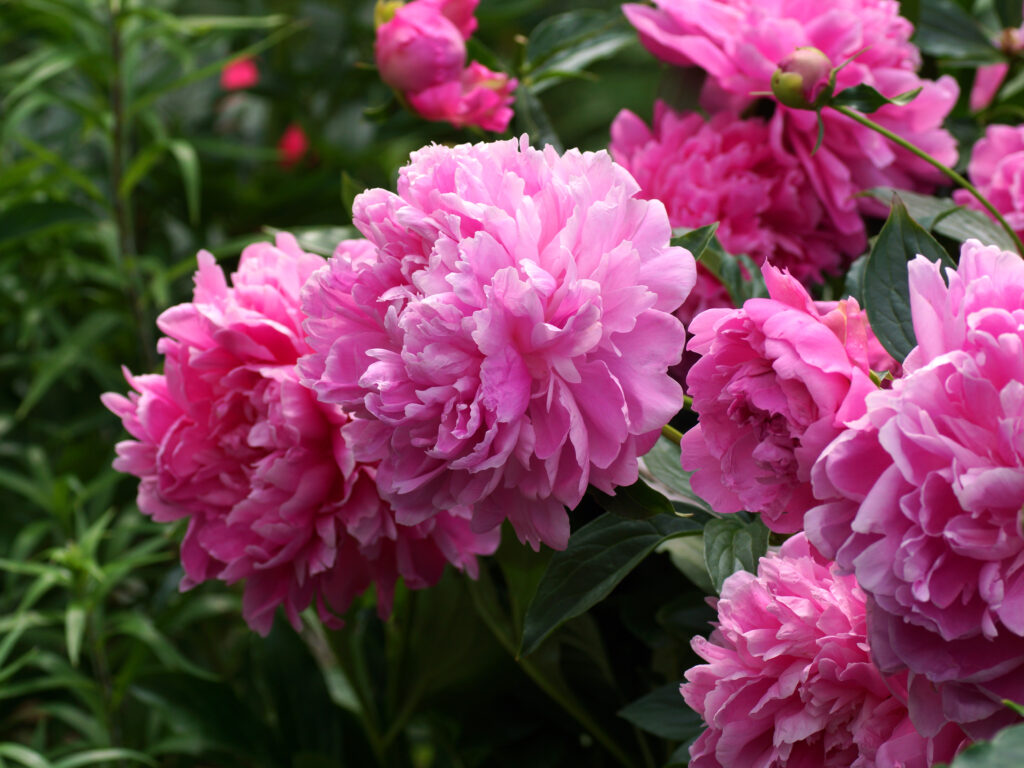
The additional petals of double peonies give them a full, fluffy, and luxuriant look.
©Natali22206/Shutterstock.com
How to Grow Peonies: USDA Growing Zones
Peonies are hardy perennial plants that can grow in a range of USDA Hardiness Zones, depending on the cultivar and growing conditions. Most peony cultivars can grow in USDA Hardiness Zones 3-8, although some cultivars may be better suited to certain zones within that range. If you are unsure of your zone, you can find it here.
Herewith is a breakdown of the USDA Hardiness Zones and some of the general characteristics of peonies that can grow in each zone:
- Zones 3-4: These are colder regions where winter temperatures can drop to -40 degrees Fahrenheit/C. Many peony cultivars can thrive in these zones, especially the herbaceous peonies that are commonly grown in gardens.
- Zones 5-6: These are moderate to cold regions where winter temperatures can range from -20 to -10 degrees Fahrenheit (-28 to -23 C). Most peony cultivars, including both herbaceous and tree peonies, can grow well in these zones.
- Zones 7-8: These are moderate to mild regions where winter temperatures rarely drop below 0 degrees Fahrenheit (-17 C). While some peony cultivars can grow well in these zones, they may require more careful attention to growing conditions, such as soil moisture and sunlight exposure, to avoid problems like rot and fungal diseases.
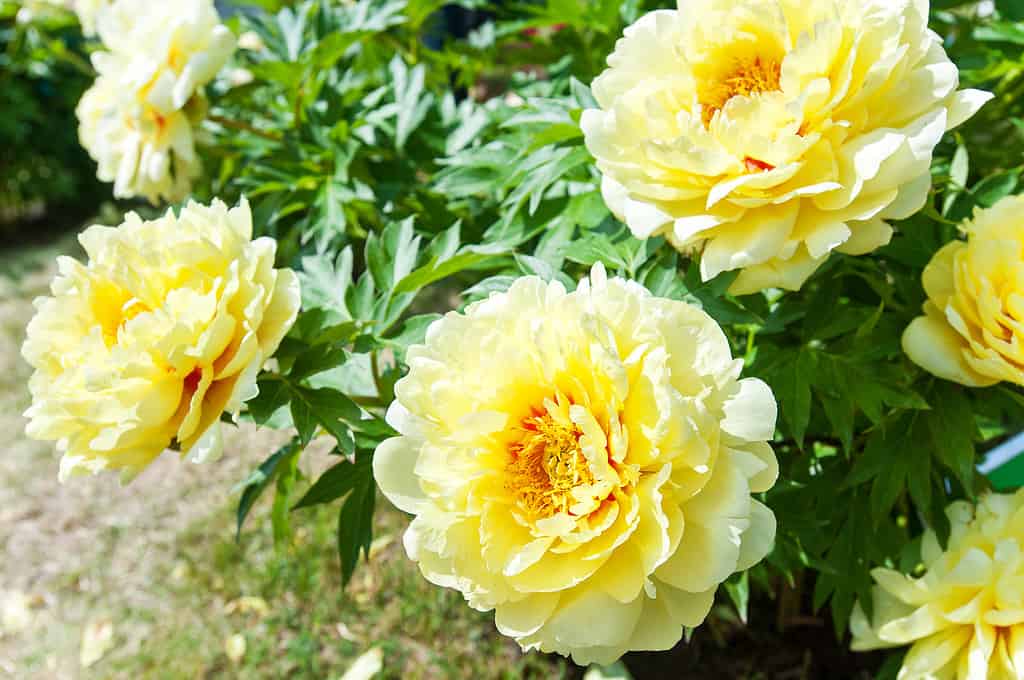
Peonies are hardy perennial plants that can grow in a range of USDA Hardiness Zones, depending on the cultivar and growing conditions.
©AnnaElizabeth photography/Shutterstock.com
Five Fragrant Facts about Peonies
- The Netherlands produces more peonies than any other country, growing approximately 50 million stems annually.
- Peonies are named after Paeon, a character from Greek mythology. According to legend, Paeon was a student of the god of medicine, Asclepius, who was jealous of Paeon’s healing abilities. To protect him from the jealous god, Zeus transformed Paeon into a peony flower.
- In Chinese culture, peonies are considered a symbol of wealth and prosperity. In Western cultures, peonies are often used in wedding bouquets and other romantic arrangements.
- Peonies are the state flower of Indiana
- The Italian adventurer Marco Polo called peonies roses as big as cabbages.
The photo featured at the top of this post is © iStock.com/yrabota
Thank you for reading! Have some feedback for us? Contact the AZ Animals editorial team.







